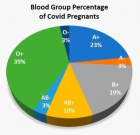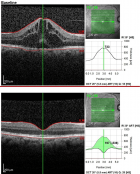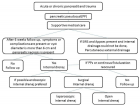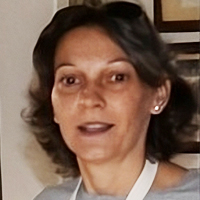Abstract
Research Article
3-D Current Density and Magnetic Field of 3-D MR Scanner Gradient Coil
Željko Đ Vujović*
Published: 28 June, 2024 | Volume 7 - Issue 1 | Pages: 086-092
The topic of this paper is to describe the 3-D current density in the windings of a 3-D coil, which fills the volume between two coaxial cylinders at a precisely defined distance from each other, and which serves to generate a magnetic field gradient in the center of the cylinder axis. The 3-D current density is considered an unknown input quantity, which is calculated from the known gradient magnetic field output. It is an inverse problem in mathematics, where the direct problems are the calculation of unknown output quantities based on known input quantities. Fourier series expansion methods in the context of cylindrical coordinates were used to describe the 3-D current density. In that case, Bessel functions are used as development components. The current densities, at each point in space, were lined up to represent current lines. Each power line is associated with a coil winding through which a current of a certain strength flows. After that, the principle of discretization of coil windings was applied. Each winding is divided into a large number of elementary segments that were considered as current elements, which create, based on Bio-Savar's law, an elementary magnetic field. In this way, the total, continuous magnetic field is broken into many elementary components, which come from different current elements. An important result of this process is that each current element can be controlled independently by a current source. This means that the output magnetic field of the gradient can be controlled by current sources, which are the input sizes, and this is what is at the core of the topic of this paper.
Read Full Article HTML DOI: 10.29328/journal.ijpra.1001090 Cite this Article Read Full Article PDF
Keywords:
Magnetic field; Gradient; 3-D coil; 3-D current density; Fourier series; Bessel functions; inverse problem
References
- Turner R. Gradient coil design: a review of methods. Magn Reson Imaging. 1993;11(7):903-20. doi: 10.1016/0730-725x(93)90209-v. PMID: 8231676.
- Veght V, Zhaw H, Galloway GJ, Doddrell DM, Breton IM. The design of planar gradient coils. Part I: A winding path correction method. Concepts Magn Reson Part B Magn Reson Eng. 2005;27B(1):17-24. doi: 10.1002/cmn.b.20049.
- Garrido Salamon CE, Gea Vidoto EL, Martins MJ, Tannus A. Optimization of saddle coils for magnetic resonance imaging. Braz J Phys. 2006 Mar;36(1A).
- Michael Poole "Improved Equipment and Techniques for Dynamic Shimming and High Field MRI", Thesis submitted to the University of Nottingham for the degree of Doctor of Philosophy, August 2007.
- Rashdy Shah Ahmad, Amirudin Bin Sharri, Chew Teong Han, "Magnetic Field Simulation of Golay Coil", Journal of Fundamental Sciences, 30 October 2008.
- Franz Schmitt, Karl Schall, "The Gradient System", Proc. Intl. Soc. Mag. Reason. Med. 21 (2013)
- Coillet C, Nativel E, Zanca M, Goze–Bas C. The magnetic field homogeneity of coils using the space harmonics superposition of the current density distribution. J Sens Sens Syst. 2016;5:401-408. Available from: www.j.-sens-sens-system.net/5/401/2016. doi: 10.5194/jsss-5-401-2016.
- Wu W, Zhou B, Lin Z, Wang J, Pang H, Chen L, Quan W, Lin G. Design of highly uniform magnetic field coils based on a particle swarm optimization algorithm. IEEE Access. 2019 Sep 16. doi: 10.1109/ACCESS.2019.29333608.
- Latin S, Jia F, Amrein P, Zaitsew M. Methods: Of stream functions and thin wares: An intuitive approach to gradient coil design. Front Phys. 2021;9:699468. doi: 10.3389/tphy.2021.699468.
- Conduction current. Current density. https://www.ucg.ac.me/skladište/blog-7790/objava-63790/fajlovi/PredavanjeII.pdf (Accessed: April 16, 2024).
- Continuity equation – Differential form. https://en.wikipedia.org/wiki/Continuity_equation (Accessed June 21, 2024).
- While PT, Forbes LK, Grozier S. 3-D gradient coil design - initial theoretical framework. IEEE Trans Biomed Eng. 2009 Apr;56(4).
- Huge S. Current, continuity equation, resistance and Ohm's law. Massachusetts Institute of Technology Department of Physics, 8.022 spring 2005, Lecture 7.
- While PT, Forbes LK, Grozier S. 3-D gradient coil design – initial theoretical framework. IEEE Trans Biomed Eng. 2009 Apr;56(4).
- Fourier's row. https://sr.wikipedia.org/wiki/Fourieov_red. Creative Commons License CC-BY-NC‒ SA 4.0 (Accessed: April 7, 2024).
- Encyclopedia of Mathematics. Bessel equation. https://encyclopediaofmath.org/wiki/Bessel_equation.
- Besselove funkcije. Hrvatska enciklopedija, mrežno izdanje, Leksikografski zavod Miroslav Krleža, 2013-2024. https://enciklopedija.hr/clanak/besselove-funkcije (Accessed April 22, 2024).
- Encyclopedia of Mathematics. Cylinder functions. https://encyclopediaofmath.org/wiki/Cylinder_functions.
- Encyclopedia of Mathematics. Cylinder functions of arbitrary order. https://encyclopediaofmath.org/wiki/Cylindar_functions#Cylinder_functions_of_arbitrary_order.
- Encyclopedia of Mathematics. Gamma function. https://encyclopediaofmath.org/wiki/Gama-function.
- Gama-funkcija. Hrvatska enciklopedija, mrežno izdanje, Leksikografski zavod Miroslav Krleža, 2013-2024. https://www.ecikloedija.hr/gama-funkcija (Accessed April 22, 2024).
- Encyclopedia of Mathematics. Fourier Bessel series. https://encyclopediaofmath.org/wiki/Fourier_Bessel_series.
- BRITANIKA, The Editors of Enciklopedia, Biot-Savarot-law, Enciklopedia Britanika, February, 2024. https://www.britanika.com/science/Biot-Savarot-law Creative Commons Licenses CC-BY-NC‒ SA 4.0 (28. 05. 2024.)
Figures:
Similar Articles
-
Bio-moleculear thermal oscillator and constant heat current sourceR Panahinia*,S Behnia. Bio-moleculear thermal oscillator and constant heat current source. . 2019 doi: 10.29328/journal.ijpra.1001016; 2: 051-055
-
Non-force electromagnetic fieldsVV Aksenov*. Non-force electromagnetic fields. . 2020 doi: 10.29328/journal.ijpra.1001021; 3: 020-045
-
Influence of high frequency rotating magnetic field on the effect of heating magnetic fluidAndrzej Skumiel*. Influence of high frequency rotating magnetic field on the effect of heating magnetic fluid. . 2021 doi: 10.29328/journal.ijpra.1001035; 4: 015-018
-
Magnetohydrodynamic (MHD) stability of wendelstein7-X reactor with resistive wall (RWMs)Ali Pazirandeh*,Mehrnaz Sadat Shariati. Magnetohydrodynamic (MHD) stability of wendelstein7-X reactor with resistive wall (RWMs). . 2021 doi: 10.29328/journal.ijpra.1001039; 4: 033-038
-
Non-force electromagnetic fields in nature and experiments on earth: Part 2VV Aksenov*. Non-force electromagnetic fields in nature and experiments on earth: Part 2. . 2020 doi: 10.29328/journal.ijpra.1001026; 3: 075-114
-
Magnets, Gradients, and RF Coils of MR ScannersŽeljko Đ Vujović*. Magnets, Gradients, and RF Coils of MR Scanners. . 2023 doi: 10.29328/journal.ijpra.1001062; 6: 128-135
-
Unsteady and Incompressible Magneto-Hydrodynamics Blood Flow in an Inclined Cylindrical ChannelLiaqat Hussain*, Salah Uddin, Asif Shahzad. Unsteady and Incompressible Magneto-Hydrodynamics Blood Flow in an Inclined Cylindrical Channel. . 2023 doi: 10.29328/journal.ijpra.1001065; 6: 154-159
-
3-D Current Density and Magnetic Field of 3-D MR Scanner Gradient CoilŽeljko Đ Vujović*. 3-D Current Density and Magnetic Field of 3-D MR Scanner Gradient Coil. . 2024 doi: 10.29328/journal.ijpra.1001090; 7: 086-092
Recently Viewed
-
Fixed functional Appliances in Orthodontics-A reviewDevinder Preet Singh*,Ramanpreet Kaur . Fixed functional Appliances in Orthodontics-A review. J Oral Health Craniofac Sci. 2018: doi: 10.29328/journal.johcs.1001021; 3: 001-010
-
Open bite malocclusion: An overviewRohit Kulshrestha*,Mohamed Abdul Wajid,Pratik Chandra,Kamlesh Singh,Ramji Rastogi,Vinay Umale. Open bite malocclusion: An overview. J Oral Health Craniofac Sci. 2018: doi: 10.29328/journal.johcs.1001022; 3: 011-020
-
Large perforating Submandibular Stone-A Case ReportFaaiz Alhamdani*. Large perforating Submandibular Stone-A Case Report. J Oral Health Craniofac Sci. 2018: doi: 10.29328/journal.johcs.1001023; 3: 021-024
-
Pathological Findings on Dental Panoramic Tomograms of Edentulous Patients Seen at a University HospitalCyril Nyalik Ogada*,Ouma DO,Mutave RJ. Pathological Findings on Dental Panoramic Tomograms of Edentulous Patients Seen at a University Hospital. J Oral Health Craniofac Sci. 2018: doi: 10.29328/journal.johcs.1001024; 3: 025-028
-
Peaceful BridgingRS Carlson*. Peaceful Bridging. J Oral Health Craniofac Sci. 2018: doi: 10.29328/journal.johcs.1001025; 3: 029-037
Most Viewed
-
Evaluation of Biostimulants Based on Recovered Protein Hydrolysates from Animal By-products as Plant Growth EnhancersH Pérez-Aguilar*, M Lacruz-Asaro, F Arán-Ais. Evaluation of Biostimulants Based on Recovered Protein Hydrolysates from Animal By-products as Plant Growth Enhancers. J Plant Sci Phytopathol. 2023 doi: 10.29328/journal.jpsp.1001104; 7: 042-047
-
Sinonasal Myxoma Extending into the Orbit in a 4-Year Old: A Case PresentationJulian A Purrinos*, Ramzi Younis. Sinonasal Myxoma Extending into the Orbit in a 4-Year Old: A Case Presentation. Arch Case Rep. 2024 doi: 10.29328/journal.acr.1001099; 8: 075-077
-
Feasibility study of magnetic sensing for detecting single-neuron action potentialsDenis Tonini,Kai Wu,Renata Saha,Jian-Ping Wang*. Feasibility study of magnetic sensing for detecting single-neuron action potentials. Ann Biomed Sci Eng. 2022 doi: 10.29328/journal.abse.1001018; 6: 019-029
-
Pediatric Dysgerminoma: Unveiling a Rare Ovarian TumorFaten Limaiem*, Khalil Saffar, Ahmed Halouani. Pediatric Dysgerminoma: Unveiling a Rare Ovarian Tumor. Arch Case Rep. 2024 doi: 10.29328/journal.acr.1001087; 8: 010-013
-
Physical activity can change the physiological and psychological circumstances during COVID-19 pandemic: A narrative reviewKhashayar Maroufi*. Physical activity can change the physiological and psychological circumstances during COVID-19 pandemic: A narrative review. J Sports Med Ther. 2021 doi: 10.29328/journal.jsmt.1001051; 6: 001-007

HSPI: We're glad you're here. Please click "create a new Query" if you are a new visitor to our website and need further information from us.
If you are already a member of our network and need to keep track of any developments regarding a question you have already submitted, click "take me to my Query."

















































































































































